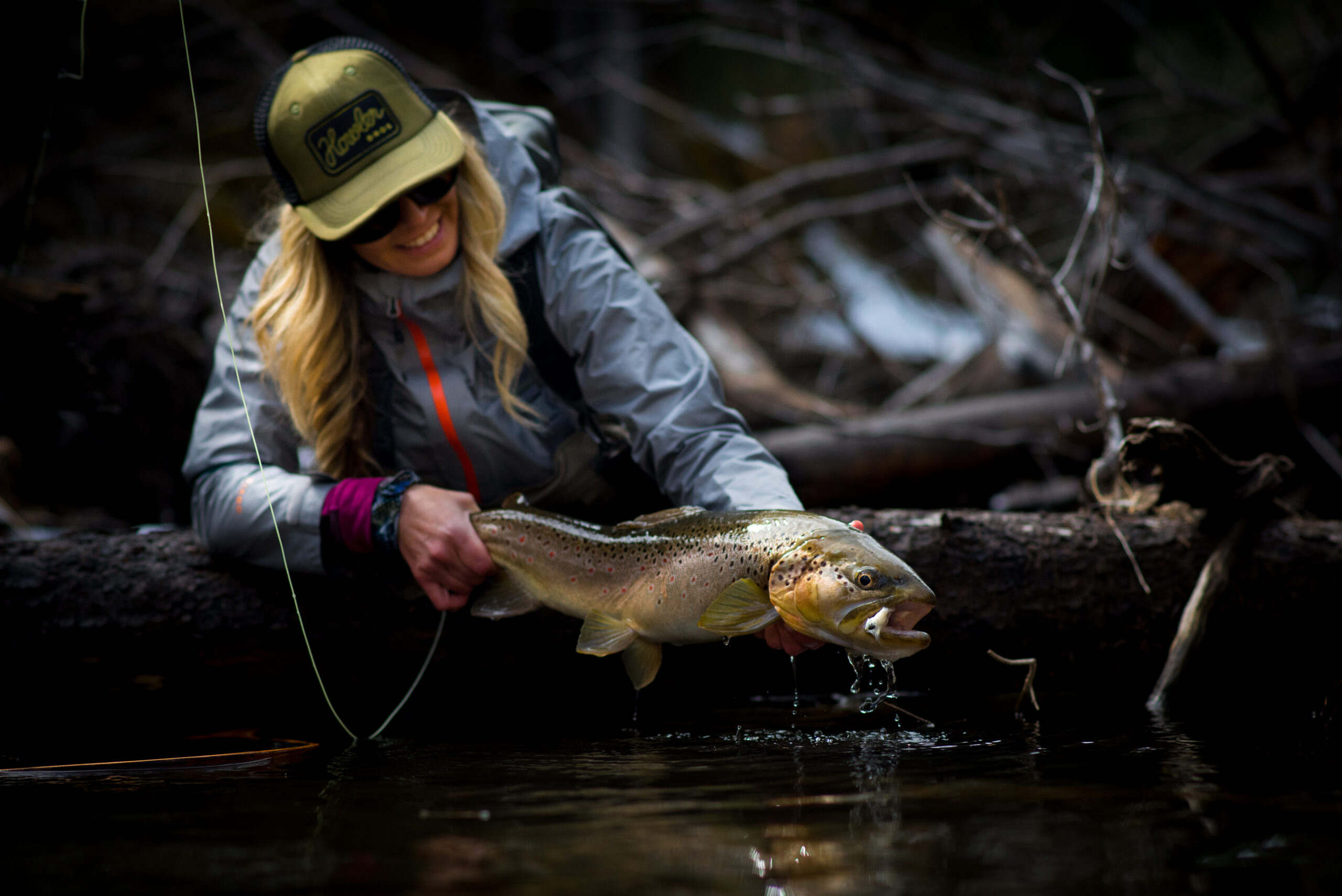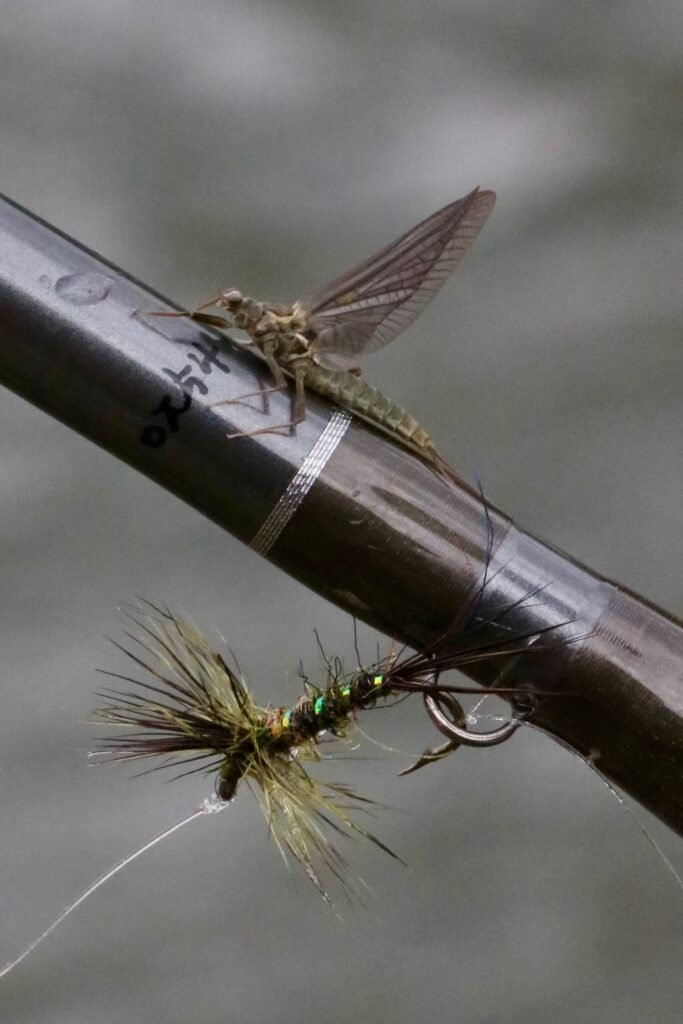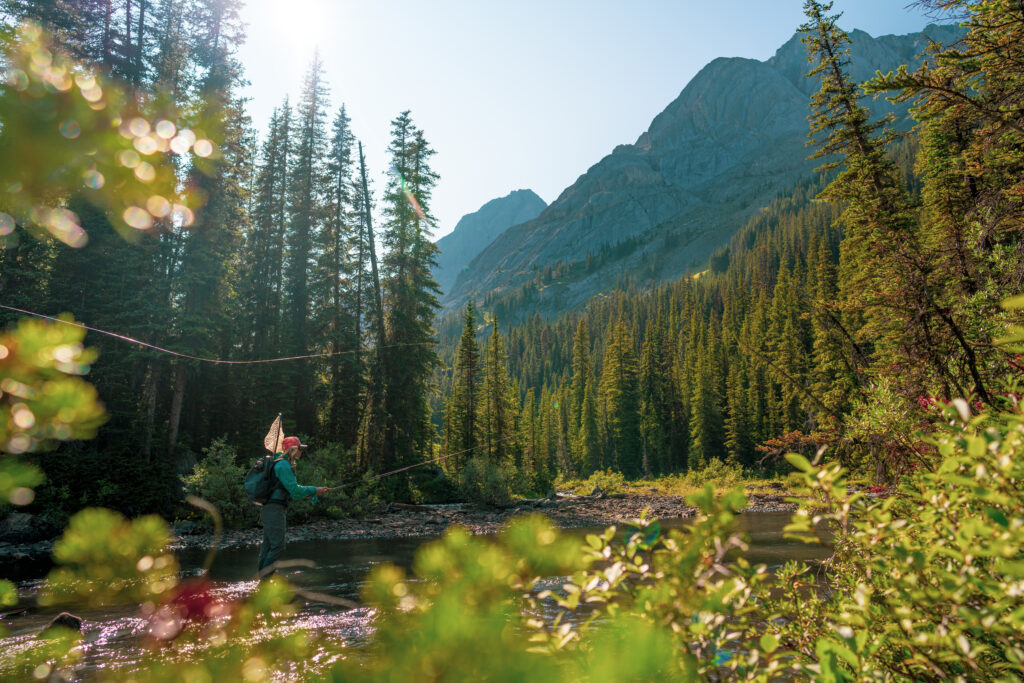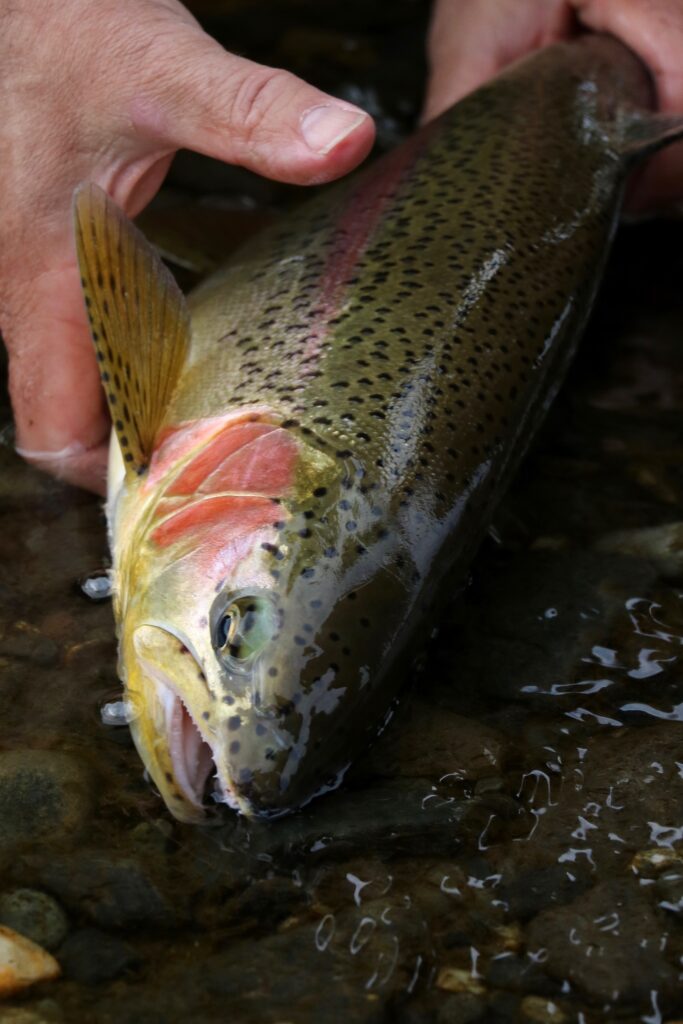
The Missouri River in Montana is a fine place to go for a serving of humble pie. The hatches are often heavy and the fish seem to appreciate them, frequently gathering in groups to feed daintily in the glassy currents. But the smooth surface of the water and the ever-present assembly of fly fishers make the trout – well – just plain hard to fool most of the time.
There was one such day when Lynda and I walked in a short distance to a lovely long flat in hopes of meeting some pale morning dun mayflies along with a few rainbow and brown trout. Just where we arrived at the water an obviously good fish was rising quite nicely – delicately sipping something small off the surface every ten seconds or so. We each had a try at this fish with no success. The impatient angler – yours truly – left that spot and went looking for other fish. The determined angler – Lynda – stayed, on the premise that it’s rarely a good idea to leave a fish in order to find a fish.
I came back an hour or so later and they were both still there. Lyn had tried a number of the usual pale morning dun suspects but the fish was still winning by a wide margin. One of us said to the other, “Do you think he’s actually eating PMDs?” The other said, “I dunno.” Then we noticed the occasional caddisfly amongst more obvious mayflies, the former likely left over from an emergence the previous evening while we were having dinner or were sound asleep. “It’s probably worth trying a caddis,” one of us said. Lynda changed to a dry caddis and made several nice casts with good drifts but still received no love. Then I had the idea to trim the hackle off an Elk Hair Caddis, tear off about half the wing, rough it up a bit, and throw it in front of the fish without any floatant. The thought was to try to imitate a low-floating, dead caddis left over from the previous hatch – the caddisfly’s version of a spent spinner. I didn’t think it would work but by now you know where the story is going. On her first cast, the fish ate it confidently.

Photo credit: Jim & Lynda McLennan
This episode got me thinking that while we should do all the “big things” properly by using the right flies and suitable leader, making a careful approach, avoiding drag etc. – sometimes success seems to depend as much on the little things as the big things. And when you’ve done all the big things you can do, there’s nothing left but little things. Here are some I’ve stumbled across.
Stand in the Best Place
Sometimes changing your position just a little makes it much easier to achieve a drag-free, acceptable-to-a-fish drift with a dry fly. A good example is when you’re working up a nice current seam where there is slow water along the bank and a strong current just a few feet out from the bank. If you stand on the bank and angle your cast up and out, the fly will land in the right spot on the edge of the current seam, but much of your fly line will lie on the slow water. As the fly drifts down the seam a right-angle bend will form in your line and/or leader. Once that happens you either have too much slack to set the hook if a fish takes, or the fly stops drifting naturally, resulting in a draggy drift that’s laughable to the fish. The solution is often to simply take a couple of steps out into the water (assuming, of course, that it’s safe to do so), and cast directly upstream so the fly line lands on water that’s moving the same speed as the water the fly is in.
Other times standing in the best place simply means getting to a spot where you can cast a comfortable distance rather than straining to the limit of your ability. Think about this before you start casting. Check the distance to the target, the currents between you and the target that may cause drag, and whether there is clear space for a backcast.

Photo credit: Faceless Fl y Fishing
Move to the Other Side of the Creek
If you always find yourself casting from the “easy” side of the stream, as evidenced by the well-worn path along the bank, you’ll be doing exactly what everyone else does. You might also be throwing the same flies as everybody else if you happened to visit the same fly shop or website they did. Look the situation over. Although the walking or wading might be more difficult on the other side, you’ll likely have a less sophisticated audience of trout over there, and possibly an easier time getting a good drift. Of course you should only do it if it’s safe to cross.
Check Your Fly – Often
Each time your fly finds its way into your hands for any reason – to tie it on, to take it off, to remove debris, to apply floatant, to attach weight to the leader – check to make sure the fly is still whole (ie no parts missing, not twisted around the hook, not torn up), and the hook is sharp. While you’re at it, check the tippet for wind knots and remove them or cut them out and re-tie with proper knots.
Fish at the Right Depth
Okay, this is more of a big thing than a little thing, but it’s really important. It applies to nymph and streamer fishing. If you’re using nymphs, unless there’s a serious emergence in progress your fly should be near the bottom of the stream. This is true whether you’re fishing water that’s two-feet deep or five-feet deep. Don’t make the assumption that because you bought a “weighted nymph” the fly will automatically reach the bottom. That depends on the speed and depth of the water. If it’s not getting there (as evidenced by no “indications” from the indicator, no fish, and no hangups on the bottom), add weight to the leader. Often the addition of a single split shot makes the difference you need. And if one weight doesn’t do it, add another and keep adding until you’re scraping the bottom or hanging up on it from time to time.
It’s not imperative to get a streamer near the bottom, but it’s never wrong to do so. So try the streamer as-is first, and if it doesn’t work, add weight to the leader or switch to a sinking leader or a sink-tip line. You can also cast farther upstream to give the fly more time to sink before it comes tight and swings in the current.
Don’t Say “Oh Well”
You’re fishing a size 14 or so dry fly on something like 4X tippet. Nothing’s happening and you decide to try a few casts with a fly about size 6, maybe a hopper or a streamer. As you’re removing the dry, a debate occurs in your head: “I should probably beef up that tippet. Yeah, but that would mean tying an extra knot. I’m only going to make a few casts. Oh well, I won’t bother. What could go wrong?” You can get away with this most of the time but eventually the bigger fly will do what you hope it will, and then you’ll break that big fish off right on the strike. I’ve done this and I bet you have too. Not knowing the importance of using heavier tippet with bigger flies is a reasonable excuse, but if we know it but don’t do it – well, maybe we deserve what we get.
Apply this premise to other things too. If you have a couple of good strikes but don’t hook the fish (check that, if you have one strike but don’t hook up), examine your fly to see that its point is still there, that the point is sharp and the tippet isn’t knotted or tangled around the hook. Most of us wait until we’ve had several strikes before bothering to do this. That’s a bad plan. Do what you know you should do. Don’t say “Oh well.”
If It’s Fixable, Fix It
This one is a relative of the previous one. We’re fishing dry flies and after awhile my companion says, “My fly is sinking.” Being a sarcastic type, I might respond with something like, “Gee, it’s too bad there isn’t something you can do about that.” If your dry fly starts sinking, put more floatant on it. Likewise if you can’t see your dry fly because it’s too small or the water is too rough or the light is bad, do something about it. Put on a more visible fly, fish the same fly on a short dropper behind a more visible dry fly, or put a tiny tuft of high-vis strike-indicator yarn on the tippet about a foot from the fly.
Give the Fish a Different Look
If you’re still with me, remember back to the beginning of the story. When the fish aren’t buying what you’re selling, it’s time to change something. Of course you can change the fly, but you can also change the look of the fly you’re already using. You can trim down a dry or a nymph. You can fish a dry without floatant first, to represent an insect that’s drifting low in the film, and if it doesn’t work that way, apply paste floatant to make it float a little higher. After that you can give the same fly a dose of fine powdered floatant (Frog’s Fanny, and others) to make the fly stand even higher on the water. At each stage the amount of refraction and distortion will change, giving the fly three different looks from the fish’s viewpoint underneath it. Similarly you can fish a small unweighted nymph like a Pheasant Tail as it is, then apply floatant on the leader to within a foot of the fly, which will keep the fly near the surface. Then you can put floatant on the nymph itself to keep it right in the film, effectively turning it into an emerger.
Give Them Something They Haven’t Seen
I used to fish the famous spring creeks in Montana’s Paradise Valley every spring. The good news is that there are lots of fish there that feed on the surface a lot, taking advantage of the reliable and predictable hatches. The bad news is that the trout in these small, heavily fished streams are some of the toughest of all trout to fool. But that’s why many fly fishers, including me, enjoy them. Like everyone else I buy a spool of 7X tippet and some microscopic wisps of lint with hooks in the local fly shop, and then spend most of the day crouching and squinting to fool an embarrassingly small number of fish. But somewhere along the way, likely to try and extract some revenge, I adopted the routine of using the last hour of my day to throw small streamers. I found that the same fish that would inspect and reject a whole series of tiny wisps of lint with hooks would sometimes turn themselves inside out to track down a size 8 Woolly Bugger. It wasn’t long till I happily embraced the sacrilege of such “coarse fishing” in this revered dry-fly water. I believe the reason it worked was because nobody else was doing it. Sometimes it works to show the fish flies they haven’t seen before or to use a method most of the other fly fishers don’t.

Photo credit: Jim & Lynda McLennan
Do Everything
There are times when none of the big or little things seem to help, and the fish win the battle in a big way. All I can suggest then is to do all the big things and all the little things you can think of.
The best example I know of is when I’m fishing tiny dry flies to actively rising trout and am getting nowhere. In these situations I might lengthen my leader by a few feet and switch to a finer tippet of fluorocarbon because it sinks and is less visible to the fish. I might also try a ridiculously small fly or at least the sparsest logical imitation I can find in my box. Or I’ll trim down my favourite imitation of the logical bug so it’s very sparse, which might help a bit with really selective trout. If possible I’ll fish a dry or emerger downstream, using a reach cast to make the the fly drift into the trout’s view before the leader does. The hope is simply that by doing everything I can think of, one of these things or the cumulative effect of all of them will make the response more favourable. If you think this smells of desperation, you’d be correct, but at this point that’s exactly where I am.
Article originally published in Volume 17, Issue 1 (Winter 2019)

